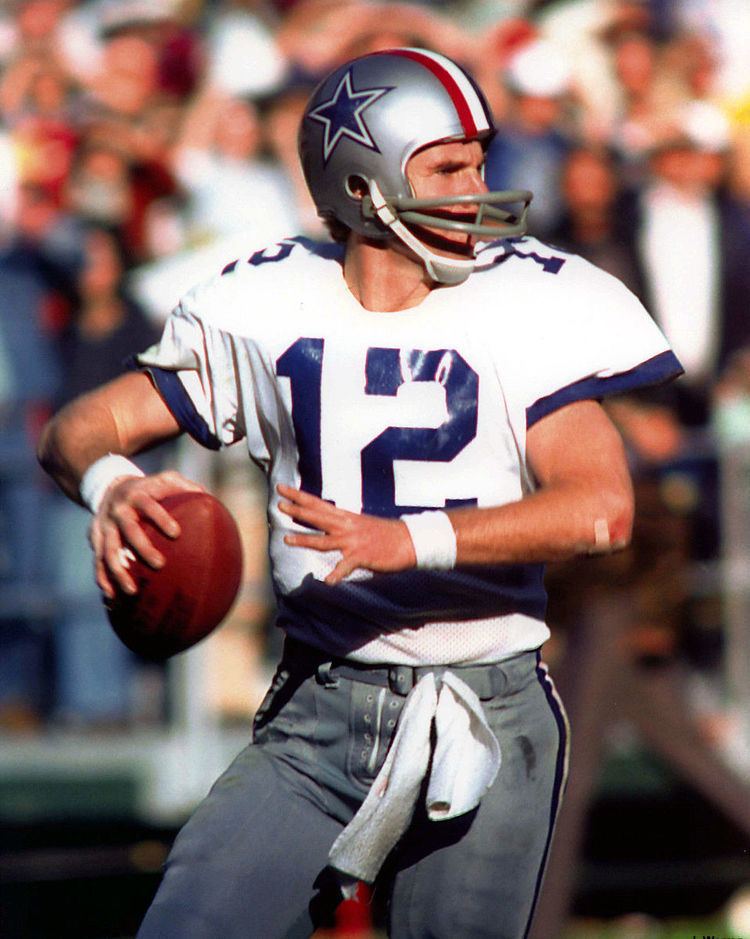 | ||
A Hail Mary pass is a very long forward pass in American football, made in desperation with only a small chance of success. In the Hail Mary pass all receivers run straight toward the end zone and the quarterback will make a long pass that is often "up for grabs". The term became widespread after a December 28, 1975 NFL playoff game between the Dallas Cowboys and the Minnesota Vikings, when Cowboys quarterback Roger Staubach (a Roman Catholic) said about his game-winning touchdown pass to wide receiver Drew Pearson, "I closed my eyes and said a Hail Mary." Previous to this play, a last-second desperation pass had been called several names, most notably the "Alley-Oop."
Contents
The expression goes back at least to the 1930s, being used publicly in that decade by two former members of Notre Dame's Four Horsemen, Elmer Layden and Jim Crowley. Originally meaning any sort of desperation play, a "Hail Mary" gradually came to denote a long, low-probability pass attempted at the end of a half when a team is too far from the end zone to execute a more conventional play, implying that it would take divine intervention for the play to succeed. For more than forty years, use of the term was largely confined to Notre Dame and other Catholic universities.
Origins
Crowley often told the story of an October 28, 1922, game between Notre Dame and Georgia Tech in which the Fighting Irish players said Hail Mary prayers together before scoring each of the touchdowns, winning the game 13-3. According to Crowley, it was one of the team’s linemen, Noble Kizer (a Presbyterian), who suggested praying before the first touchdown, which occurred on a fourth and goal play at the Tech 6-yard line during the second quarter. Quarterback Harry Stuhldreher, another of the Horsemen, threw a quick pass over the middle to Paul Castner for the score. The ritual was repeated before a third and goal play, again at Tech’s six, in the fourth quarter. This time Stuhldreher ran for a touchdown, which sealed the win for Notre Dame. After the game, Kizer exclaimed to Crowley, “Say, that Hail Mary is the best play we’ve got.” Crowley related this story many times in public speeches beginning in the 1930s.
On November 2, 1935, with 32 seconds left in the so-called "Game of the Century" between Ohio State and Notre Dame, Irish halfback Bill Shakespeare found receiver Wayne Millner for a 19-yard, game-winning touchdown. Notre Dame head coach Elmer Layden (who had played in the 1922 Georgia Tech game) afterwards called it a “Hail Mary” play.
An early appearance of the term was in an Associated Press story about the upcoming 1941 Orange Bowl between the Mississippi State Bulldogs and the Georgetown Hoyas. The piece appeared in several newspapers including the December 31, 1940 Daytona Beach Morning Journal under the headline, "Orange Bowl: [Georgetown] Hoyas Put Faith in 'Hail Mary' Pass"). As the article explained, "A ‘hail Mary’ pass, in the talk of the Washington eleven, is one that is thrown with a prayer because the odds against completion are big."
During an NBC broadcast in 1963, Staubach, then a Navy quarterback, described a pass play during his team’s victory over Michigan that year as a “Hail Mary play.” He scrambled to escape a pass rush, nearly getting sacked 20 yards behind the line of scrimmage before completing a desperation pass for a one-yard gain.
Examples
Arguably the most memorable and replayed Hail Mary pass came on November 23, 1984 in a game now known as "Hail Flutie." Boston College was losing to Miami (FL) with 6 seconds left on the clock when their quarterback Doug Flutie threw a 52-yard touchdown pass to Gerard Phelan, succeeding primarily because Miami's secondary stood on the goal line to keep the receivers in front of them without covering a post route behind them. Miami's defense was based on the assumption that Flutie couldn't throw the ball as far as the end zone, but Flutie hit Phelan in stride against a flatfooted defense a yard deep in the end zone. To commemorate the play, a statue of Flutie in his Hail Mary passing pose was unveiled outside Alumni Stadium at Boston College on November 7, 2008.
Other noteworthy examples include:
In other fields
The term "Hail Mary pass" has become generalized to refer to any last-ditch effort with little chance of success.
In basketball, a "Hail Mary shot" or "Hail Mary throw" is a shot thrown from a place far away from the basket (e.g. behind the half court line). It is typically attempted when there is not enough time left in the period to execute a more traditional play, and (in a case where the team attempting the shot is in the final regulation period or overtime) when they are either tied or behind by no more than three points. In basketball, successful shots at the basket will count as long as the ball is released prior to the expiration of time. A scoring shot that enters the basket after time expires is called a buzzer beater (in reference to the "buzzer" that sounds to signal the end of the period).
There are similar usages in other fields, such as a "Hail Mary shot" in photography where the photographer holds the view finder of an SLR camera far from his eye (so unable to compose the picture), usually high above his head, and takes a shot. This is often used in crowded situations.
